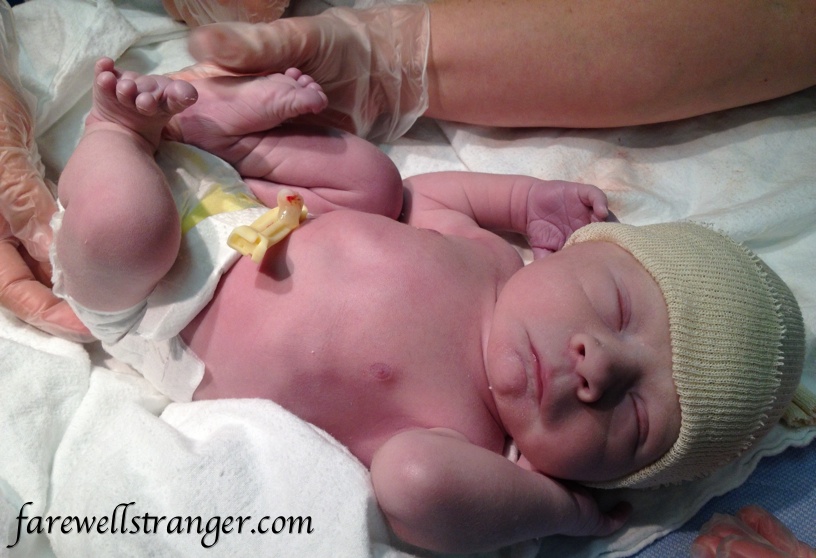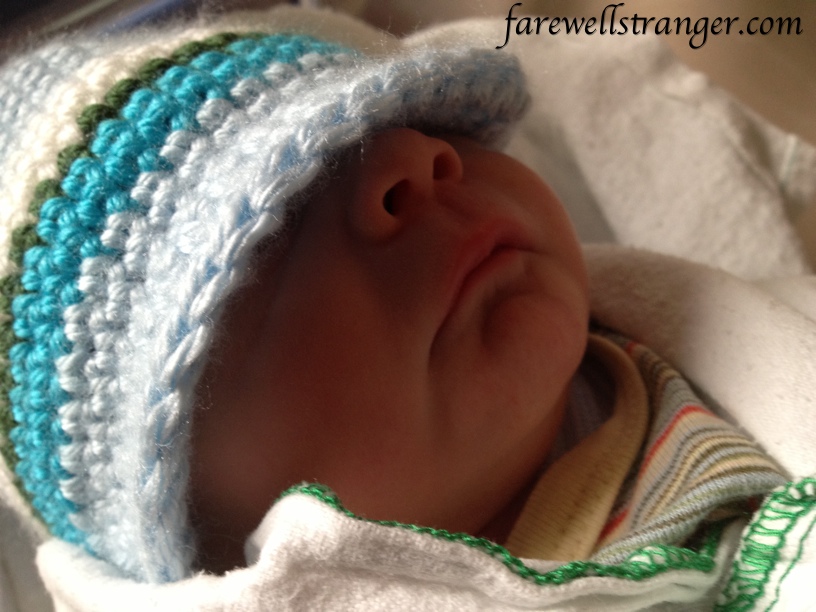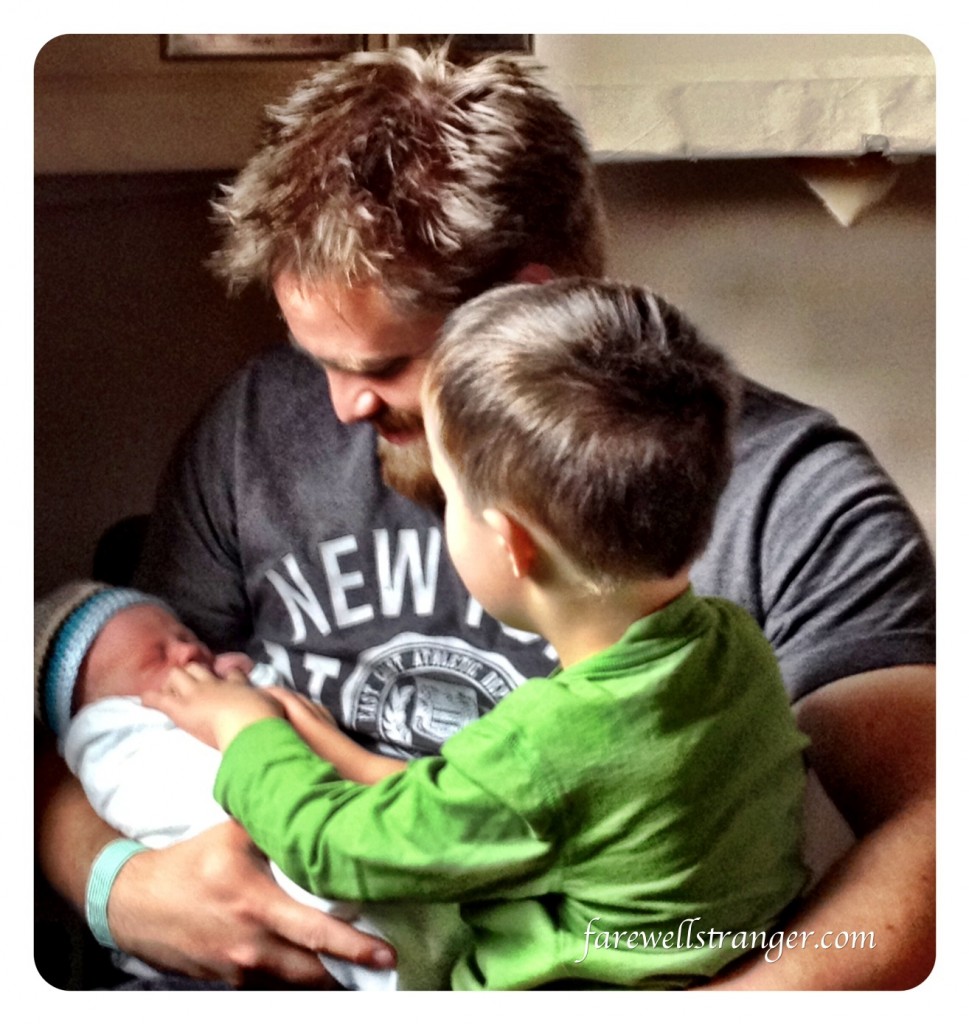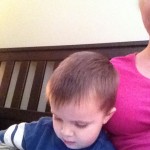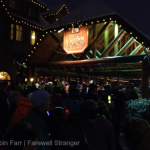In talking about Ethan’s birth after the fact, Rich and I realized we had different perspectives on it. Specifically, he remembered things I didn’t, so I asked him to write his version. I’m tempted to add editorial notes in a couple of places (mostly to defend myself!) but have resisted. I hope you enjoy it.
Robin tried to convince me that it was just false labour. That she’d been experiencing Braxton Hicks contractions for a day and a half and, aside from being tired from losing sleep, everything was normal. “Are you sure?” I asked. “Because I don’t remember seeing a grimace on your face yesterday and I’m positive I would have remembered that.”
Then her water broke.
Earlier in the day (yes, I’d left the birth partner books to the last minute) I’d read that encouraging a woman in labour to relax her jaw would also help her relax the rest of her body and make the contractions less painful. So, during a particularly hard contraction I told Robin to do just that. Please read that sentence again. I told her. Not asked. Not suggested. Told. That was my first mistake.
Now, you should know that my wife is a very independent person and has been from a young age. Her mother likes to share the story of Robin’s first sentence as evidence of her independence: “Do it self, mom!” So, you can imagine that, during the difficulties of labour, being told to do something, anything, wasn’t welcome advice. Robin’s reaction was to do the opposite, which made the contraction more painful, which made her declare, “I can’t do this anymore.”
I didn’t think much of that statement at the time but it resonates with me now. Not only could she do this but she would endure so much more before the end of the night.
During a previous visit, our midwife had shared the story of a couple who’d used guided imagery to manage contractions—a leaf rising and falling over a wave of water. It sounded corny to me at the time but it ended up being a lifeline of relief during labour. During every contraction I would describe this leaf climbing up and falling down a wave on a river. And having that leaf to follow really did seem to make the pain more manageable for Robin. So that’s what we did, every contraction – just ride with that leaf.
When it was time to go to the hospital I packed our bag in the car, got Robin settled in the passenger seat and opened the garage door. To my horror I saw that the first snowfall of the season was here. Crap!
I pulled out of the garage and slowly started driving. Every few minutes Robin would grab my hand and say, through gritted teeth, “Do the leaf. Do the leaf.”
So there we were. Wife in labour. Driving to the hospital. In the dark. Snow piling up. Visibility diminishing. People driving like it was the first snowfall of the year. And I kept thinking to myself, “Please don’t crash. I don’t want my son born in a ditch,” all the while trying to describe a leaf on a river.
Our midwife arrived at the hospital before us. (Apparently it’s quicker to get around if you’re not doubled over in pain every four minutes. Who knew?) Robin was dressed in a fetal heart rate monitor and a band to measure contractions—precautionary side-effects of her previous C-section. That’s when we discovered something was wrong. During each contraction, the baby’s heart rate dropped. His umbilical cord was being compressed and he was in danger of oxygen deprivation.
The obstetrician on duty was called in and a catheter was inserted into Robin’s uterus so fluid could be pumped in to provide cushioning for the cord during contractions. If that didn’t work Robin would require an emergency C-section.
C-section. It’s a four-letter word in our house and it’s something I’d been dreading. Not on my account but for Robin.
Personally, I would have welcomed another C-section. My fear leading up to the births of both my sons, was that I wouldn’t be an good birth partner. That I would fail to support Robin in the way she needed. That the words I’d choose would make the experience worse or that I wouldn’t be able to physically endure a long labour. (“Sorry honey, you keep going. I’m exhausted.”) The C-section that brought Connor into this world spared me from realizing that fear. If I never had to find out how I’d do as a birth partner, that was fine with me. Bring on the C-section.
But for Robin, having a C-section for Connor’s birth was a robbery. My wish for her, for this delivery, was that she be given the chance to give birth on her terms. That she be able to test herself, if that’s what she needed. To fight on behalf of her helpless son and shepherd him into this world. To prove to something deep inside that she had what it took to be the mother she needed to be.
The additional fluid worked, the baby’s heart rate stayed up, and Robin continued to labour.
During most of her labour Robin was on her feet, walking around the room. During contractions she gripped my hands and rested her forehead on my chest. Towards the end she would growl and implore this baby to come out.
Then came the overwhelming need to push.
Gathered in the room were at least ten people: Robin, two midwives, the obstetrician, her resident, a nurse, three members of the NICU, and me. The additional fluid had leaked out and the umbilical cord was again being compressed. If this baby wasn’t delivered right away then the obstetrician had no choice but to use a vacuum to pull him out—something we wanted to avoid.
During the next contraction Robin was to resist as long as she could and then push with all her might—even after the contraction ended. The problem was that five people were trying to explain the plan to her at once.
She looked over at me with a mix of confusion and exhaustion and said, “Tell me what to do.”
We waited. Then she pushed with everything she had. When she could no longer hold her legs up, our midwife and I held them for her. She pushed like she’d already given birth to three kids. I could see the baby’s head. She growled. She pushed again and in a sublime moment, his head came out. One more push and out followed the rest of his body.
Immediately I felt an overwhelming sense of joy, pride and relief. Joy in the fact that he was here and healthy. Pride in Robin and what she’d accomplished. Relief that it was all done.
Only it wasn’t all done. There was a problem. The placenta hadn’t released from the uterus and the obstetrician would have to remove it manually.
Our midwife offered Robin laughing gas and I held her hand as she screamed and screamed while the obstetrician, as carefully as she could, reached her arm inside and scraped away pieces of placenta. “Just one more time.” “I’m so sorry. Just one more time.” FOUR times.
Midwives experience a lot of deliveries. After everything was done and Robin cradled her baby to her chest, Wendy, a seasoned midwife, turned to me and said something that I’ll never forget. She’d not met many people who were able to endure what Robin just had—“She’s one tough lady.”
And I agree.
Looking for my version of this story? Start here with part one.

